

Journal of Neuroscience. Abnormal Cortical Processing of the Syllable Rate of Speech in Poor Readers. Introduction Reading proficiency relies on the confluence of rudimentary perceptual abilities and higher-order linguistic function (Schlaggar and McCandliss, 2007).
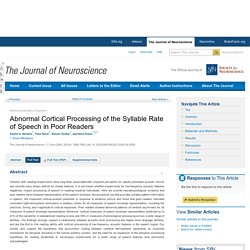
While normal reading is thought to rely on an array of abilities, it is widely thought that reading-impaired individuals suffer from a specific deficit in representing or recalling the precise phonological structure of words (Ramus, 2001). This “phonological deficit” is thought to impair reading acquisition: if the mental representation of individual speech sounds is impaired, then the necessary step of learning how to match these sounds on to letters will also be impaired. While it is widely accepted that impaired readers suffer from a phonological deficit, it is not known what causes this deficit.
Recent work has provided insight into neural mechanisms governing temporal processing of speech in the unimpaired human auditory system. Results Cortical envelope representation in “good” and “poor” readers Figure 1. Auditory Cortical Processing in Real-World Listening: The Auditory System Going Real. A Computational Model of Implicit Memory Captures Dyslexics' Perceptual Deficits. Introduction The controversy surrounding the deficits underlying dyslexics' difficulties is still unresolved.

The prevailing theory claims that dyslexics' phonological representations, whose adequacy is crucial for efficient usage of the alphabetical code, are impaired (Snowling, 2000). However, dyslexics perform well on some tasks that rely on adequate phonological representations (for review, see: Ramus and Ahissar, 2012). A computationally motivated imaging study found that dyslexics' task-specific top-down tuning to phonological processing, as revealed in their thalamic response, is impaired (Díaz et al., 2012), suggesting that it may be access to phonological representations which is deficient in dyslexia (Boets et al., 2013; Ramus, 2014).
Nevertheless, other studies have found that dyslexics' automatic responses to basic sounds are noisier than those of good readers (Nagarajan et al., 1999; Hornickel and Kraus, 2013). Results Participants' cognitive profile Table 1. Figure 1. During Visual Word Recognition, Phonology Is Accessed within 100 ms and May Be Mediated by a Speech Production Code: Evidence from Magnetoencephalography. Participants.
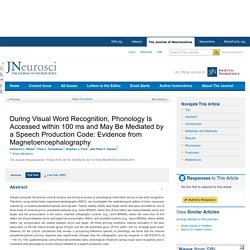
Twenty native English-speaking, strongly right-handed adults (mean age 23.2 years, SD 5.97 months; 12 female) gave informed consent to participate in the study. None had been diagnosed reading disabled and all read normally based on WRAT-III performance. Handedness was defined by the Annett Hand Preference Questionnaire (Annett, 1967). The study conformed with The Code of Ethics of the World Medical Association (Declaration of Helsinki). Stimuli. The target words were 111 English five-letter nouns and verbs, with a mean word frequency count of 19.7 (CELEX). Catch trials were randomly interspersed with experimental trials. Procedure. Participants were asked to rapidly and silently read target words and to press a button only if they spotted an animal name.
Genetic Variants of FOXP2 and KIAA0319/TTRAP/THEM2 Locus Are Associated with Altered Brain Activation in Distinct Language-Related Regions. Introduction Human language is under strong genetic influence, as indicated by familial studies of clinical populations affected by language impairment (LI) or by reading disability (dyslexia) (Pennington et al., 1991; DeFries, 1996; Stromswold, 2001).
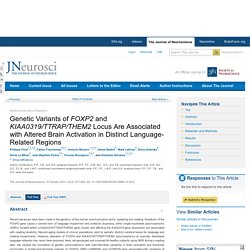
A candidate gene for LI was first evidenced in members of the KE family affected by a missense mutation in FOXP2 gene (chromosome 7q31) that disrupts the DNA-binding site of the protein (Lai et al., 2001). Towards a New Neurobiology of Language. Until ∼25 years ago, our knowledge of the brain basis of language processing, the mental faculty considered to be at the very core of human nature, derived largely from rather coarse measures (neurobiologically speaking): deficit-lesion correlations in stroke patients, electrophysiological data from electroencephalographic as well as occasional intracranial recordings (associated with surgical interventions), and relatively crude measures such as the Wada test for language lateralization.
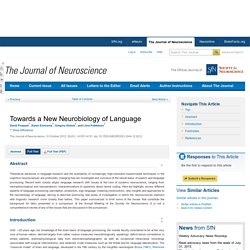
The “classical model” of brain and language, developed in the 19th century by the insightful neurologists Broca (1861), Wernicke (1874), Lichtheim (1885), and others, dominated discourse in the field for more than one hundred years. To this day the Wernicke-Lichtheim model of a left inferior frontal region and a posterior temporal brain area, connected by the arcuate fasciculus fiber bundle, is familiar to every student of the neurosciences, linguistics, and psychology. Figure 1. Figure 2. Unstable Representation of Sound: A Biological Marker of Dyslexia. Jane Hornickel1 and Nina Kraus1,2,3 +Show Affiliations Author contributions: J.H. and N.K. designed research; J.H. performed research; J.H. contributed unpublished reagents/analytic tools; J.H. analyzed data; J.H. and N.K. wrote the paper.
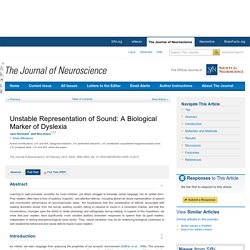
The Journal of Neuroscience, 20 February 2013, 33(8): 3500-3504; doi: 10.1523/JNEUROSCI.4205-12.2013 Abstract Learning to read proceeds smoothly for most children, yet others struggle to translate verbal language into its written form.